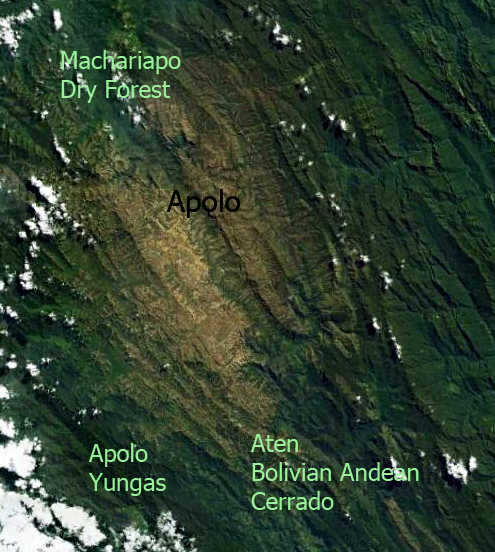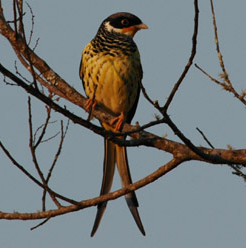Apolo
by Bennett
Hennessey
 Apolo is a stumbling town in the middle of a bizarre high Andean plataeu, that was Bolivian Andean Cerrado, but is now mostly scrub and cattle pasture. The town is your setting off point in three directions, 1) off to Aten to see the Palkachupa (Apolo) Cotinga and Green-capped Tanager in the Bolivian Andean Cerrado, 2) down the Machariapo Dry Forest to search for the Yungas Antwren, San Pedro Tanager, and Rufous-vented Ground-Cuckoo, or 3) up the road to La Paz to observe birds in the Apolo Yungas. Apolo is a stumbling town in the middle of a bizarre high Andean plataeu, that was Bolivian Andean Cerrado, but is now mostly scrub and cattle pasture. The town is your setting off point in three directions, 1) off to Aten to see the Palkachupa (Apolo) Cotinga and Green-capped Tanager in the Bolivian Andean Cerrado, 2) down the Machariapo Dry Forest to search for the Yungas Antwren, San Pedro Tanager, and Rufous-vented Ground-Cuckoo, or 3) up the road to La Paz to observe birds in the Apolo Yungas.
If you enjoy hiking, from the centre of Apolo you can
take two mule trails that travel up the plateau to another area of savannah
and forest fragments. You would need
to ask for directions to take the trail to Sarayo. The trail travels on for many kilometres, but you could walk it as long as you like, returning in a day- or camping. There is no road to this town- which is deep in the Yungas forest and could be an adventurous birding trip.
Logistics: After over ten years, the Apolo airport renovation has been completed, though 7 months in, there is still no commercial flights to the area. But at least a charter Cessna trip to Apolo is now possibe. The easiest way to visit Apolo is to rent a car from La Paz to visit the area,
being very independent with sleeping bags, camping equipment and food. With a
rental car you can camp and make several stops along the yungas (Cloud
forest) road to Apolo. Other than renting a car, the only other option are the daily busses from
La Paz,
a 16‑hour road trip that often results in arrival in Apolo at around 4
am. The busses to Apolo used to leave from Calle Vicente
Ochoa, Zona El Tejar (Detras de las Canchas, behind the football
pitch)- but I would double check this information as it is old. Never travel in the far back
seats- which expand the meaning of the word uncomfortable to painful depths.
Without a vehicle in Apolo, you can get taxis to drop you off at certain
destinations, or hike in with a sleeping bag (like the trails to Sarayoj). It is also possible to rent a motorcycle for
the day- but you need to negotiate that with someone.
 In Apolo, we recommend you stay in the Monasterio de Nuestro Senora de Nazareth hermana
Cistercienses Tel. 01022136801 which has clean rooms, inexpensive meals and a
relaxing atmosphere. The Monasterio is about four blocks from the central place on the south-east part of the town. This is a very pleasant place with large grounds which can offer pleasant local birding. Take the trail down to the river for a look at some local birds- but nothing spectacular in this highly disturbed area. In Apolo, we recommend you stay in the Monasterio de Nuestro Senora de Nazareth hermana
Cistercienses Tel. 01022136801 which has clean rooms, inexpensive meals and a
relaxing atmosphere. The Monasterio is about four blocks from the central place on the south-east part of the town. This is a very pleasant place with large grounds which can offer pleasant local birding. Take the trail down to the river for a look at some local birds- but nothing spectacular in this highly disturbed area.
From
La Paz one can
call Pancho and his wife Susana Novack in Apolo (they speak English; 0811‑9211
Entel or 0811‑9268 Apolo) to organize a birding trip down the
Machariapo and Tuichi Valleys on the Apolo‑Asariamas footpath. They are very
familiar with the area and can provide a decent non‑complicated trip,
supplying all food and transport but you need to have tents and camping
gear. Pancho designs trips for the backpacker market, so you will need to explain to him
that you want to see birds, and be firm with your demands, like sleeping in
natural settings and not ranches. Backpackers don't care, but for us,
why miss a chance at a potential new Owl. Once in
Apolo, if you don't want to pay the extra money for logistical help you can
take that role yourselves. The owners of Hotel Centenario on the main
plaza can put you in touch with people familiar with the footpath to
Asariamas who would be able to carry your gear on a mule, make camps and cook
dinner. In 2000 workers in Apolo were 40 bs and mules 70 bs a day.
Mules add a few complications as they need to feed in grassy areas, but you
feel less guilty than watching a man suffer with your pack. In 1999
they began making a road down the Machariapo valley, which in 2000 is mostly
washed out. We recommend you rent a motorcycle (moto taxi) to drop you
off at the end of the road (approx.
14 km), after most of the disturbed habitat
on the road. Here, plan to meet up with the mules and where to camp
every half days walk or how ever suits your trip. We prefer walking
ahead birdwatching, and having the workers meet us during midday with lunch
and an idea of our progress and a good camping spot. To get to the
Tuichi Valley, we recommend planning for a trip around 7 days. The
trail climbs up and over three
150
m hills. Try to suggest that you would like to
camp away from noisy rivers and the few ranches (and their roosters) in the
area. You can also ask for more information through Bird Bolivia (birdbolivia@birdbolivia.com).
|

